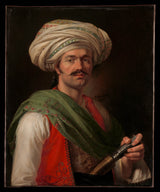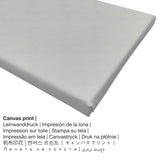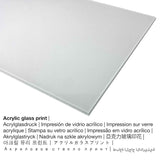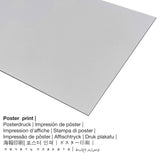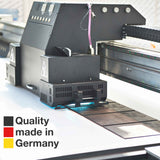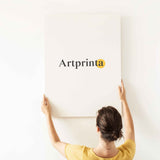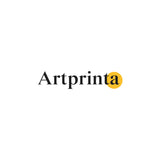Horace Vernet, 1810 - Eserese nke Mameluke, kwuru na ọ bụ Roustam Raza (ihe dịka 1781–1845) - mbipụta nka mara mma.
Ụtụ gụnyere. Mbupu gbakọrọ na ndenye ọpụpụ.
Ozi ngwaahịa dị omimi
E kere ihe osise nke oge a Horace Vernet. The 210 year-old piece of art was made with the absolute size: 29 1/2 x 24 1/4 in (75 x 61,5 cm) and was painted with the Usoro of mmanụ na kwaaji. Taa, artpiece bụ nke dijitalụ collection nke Museumlọ ihe ngosi nka nke Obodo. Ihe nka nka nke oge a, nke di na ngalaba ọha is being supplied with courtesy of The Metropolitan Museum of Art, New York, Gift of Kenneth Jay Lane, 2014. Furthermore, the artpiece has the creditline: Gift of Kenneth Jay Lane, 2014. On top of that, alignment of the digital reproduction is in Eserese format na oke nke 1: 1.2, nke pụtara na ogologo bụ 20% mkpụmkpụ karịa obosara. The photographer, military personnel, painter Horace Vernet was an artist from France, whose style was mainly Romanticism. The Romanticist painter was born in 1789 in Paris, Ile-de-France, France and passed away at the age of 74 na 1863 na Paris, Ile-de-France, France.
Ozi nkowa mgbakwunye site The Metropolitan Museum of Art (© - by The Metropolitan Museum of Art - www.metmuseum.org)
This early portrait by Vernet, the leading French battle painter of the nineteenth century, depicts one of the Mameluke soldiers who long comprised the military caste of Egypt. He is traditionally identified as Roustam Raza, who entered Napoleon’s personal service in Cairo in 1799 and remained with him until 1814. The genesis and early history of the portrait are unknown, but it is entirely possible that the well-connected Vernet, who came from a dynasty of successful artists, was able to secure a sitting with a member of the Emperor’s bodyguard.
Iberibe nkọwa nka
| Aha nke ọrụ nka: | "Portrait of a Mameluke, Said to Be Roustam Raza (ca. 1781–1845)" |
| nhazi ọkwa: | sere |
| Okwu mkpokọta: | nkà nke oge a |
| oge: | 19th narị afọ |
| Emepụtara na: | 1810 |
| Afọ nka: | ihe dị ka afọ 210 |
| Agba na: | mmanụ na kwaaji |
| Akụkụ izizi (ọrụ nka): | 29 1/2 x 24 1/4 na (75 x 61,5 cm) |
| Ụlọ ihe ngosi nka / ebe: | Museumlọ ihe ngosi nka nke Obodo |
| Ebe ebe ngosi nka: | New York City, New York, Njikota Obodo Amerika |
| website: | Museumlọ ihe ngosi nka nke Obodo |
| Licensedị ikike: | ngalaba ọha |
| Site n'aka: | Ụlọ ihe ngosi nka nke Metropolitan, New York, Onyinye Kenneth Jay Lane, 2014 |
| Ebe E Si Nweta: | Onyinye nke Kenneth Jay Lane, 2014 |
Nkọwa onye nka
| aha: | Horace Vernet |
| Aha nka ndị ọzọ: | ורנה אמיל ז'אן הוראס, Emile Jean Horace Vernet, vernet horace, M. Verne, Vernet Hor., e. j. horace vernet, Horace Vernet, E. J. H. Vernet, Vernet Horace, Vernet fils, Vernet, emil jean horace vernet, Vernet Emile-Jean-Horace, Vernet Emile Jean Horace, H. Vernet |
| okike nke onye nka: | nwoke |
| Obodo onye nka: | French |
| Ọrụ: | military personnel, photographer, painter |
| Country: | France |
| nhazi ọkwa: | omenkà nke oge a |
| Ụdị nka: | Ihunanya |
| Nwụrụ anwụ: | 74 afọ |
| Afọ ọmụmụ: | 1789 |
| Ebe amụrụ onye: | Paris, Ile-de-France, France |
| Afọ nwụrụ: | 1863 |
| Nwụrụ na (ebe): | Paris, Ile-de-France, France |
Họrọ ụdị ebipụta nka nka
The product dropdown menu provides you with the possibility to select the material and size of your choice. That is why, we allow you to choose among the following options:
- Mpempe akwụkwọ (ihe kwaaji): A poster print is a printed canvas paper with a slight texture on the surface, which reminds the original version of the masterpiece. It is suited for putting the fine art print in a customized frame. Please note, that depending on the absolute size of the poster print we add a white margin of something between 2 - 6cm around the print motif, which facilitates the framing.
- Mbipụta kwaaji: The canvas print is a printed canvas stretched on a wood frame. It creates a extra impression of three dimensionality. The advantage of canvas prints is that they are relatively low in weight. This means, it is easy to hang the Canvas print without the help of additional wall-mounts. Hence, canvas prints are suitable for all kinds of walls.
- Aluminom dibond mbipụta (ọla): Aluminium Dibond prints are metal prints with a true depth, which makes a modern impression with a surface , which is non-reflective. The Aluminium Dibond Print is your best introduction to reproductions made with aluminum. For your Direct Print On Aluminum Dibond, we print your chosen artpiece right onto the aluminium white-primed surface. Colors are luminous and bright, fine details of the print are very clear.
- Mbipụta enyo acrylic: A glossy acrylic glass print, often described as a print on plexiglass, will change your favorite artwork into amazing décor. The artwork is made with the help of modern UV direct print machines. This has the effect of stunning, vivid color tones. With an acrylic glass fine art print contrasts plus smaller color details will be visible thanks to the very fine tonal gradation. The acrylic glass protects your selected art print against sunlight and external influences for many years.
Ngwaahịa a
| Ụdị edemede: | mmepụta nka |
| Usoro mmeputakwa: | dijitalụ mmeputakwa |
| Usoro nhazi: | Mbipụta UV ozugbo |
| Mmalite nke ngwaahịa a: | emere na Germany |
| Ụdị ngwaahịa: | mmepụta ihe na-achọ |
| A na-atụ aro iji ngwaahịa eme ihe: | Ụlọ ihe osise nka, mkpokọta nka (mmepụta) |
| Ndozi onyonyo a: | nhazi ihe osise |
| Ụdị anya: | 1: 1.2 - ogologo: obosara |
| Mmetụta akụkụ: | ogologo bụ 20% mkpụmkpụ karịa obosara |
| Nhọrọ akụrụngwa: | ígwè obibi akwụkwọ (aluminium dibond), akwụkwọ mmado (akwụkwọ kwaaji), mbipụta enyo acrylic (nke nwere ezigbo mkpuchi iko), mbipụta akwụkwọ. |
| Nhọrọ nke akwa akwa n'elu etiti ihe ndọtị (mbipụta akwa akwa): | 50x60cm - 20x24", 100x120cm - 39x47", 150x180cm - 59x71" |
| Mpempe iko acrylic (nwere ezigbo mkpuchi iko) nha dị iche iche: | 50x60cm - 20x24", 100x120cm - 39x47" |
| Mbipụta akwụkwọ mmado (akwụkwọ kwaaji): | 50x60cm - 20x24", 100x120cm - 39x47" |
| Mpempe akwụkwọ Dibony (ihe alumnium) nha: | 50x60cm - 20x24", 100x120cm - 39x47" |
| Nhazi mbipụta nka: | biko rịba ama na emebeghi mmeputakwa a |
Disclaimer: We try whatever we can to depict the products as closely as possible and to illustrate them visually in our shop. Still, the tone of the print materials and the print result can vary to a certain extent from the presentation on your device's monitor. Depending on the settings of your screen and the nature of the surface, not all colors can be printed one hundret percent realistically. Since the art prints are printed and processed manually, there might as well be slight discrepancies in the motif's exact position and the size.
Ederede a bụ ikike ọgụgụ isi ma chekwaa ya site na nwebisiinka © - www.artprinta.com (Artprinta)

